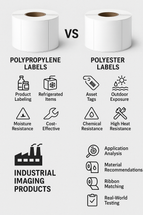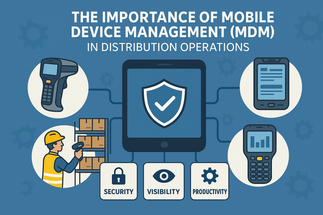Thermal printing has become one of the most widely used printing technologies in the world, powering applications from shipping labels and receipts to ID badges and compliance labeling. Unlike traditional printers that rely on liquid ink or toner powder, thermal printers use heat to create images and text with speed, clarity, and efficiency.
This paper explains how thermal printing works, the two main printing methods, the advantages and limitations of the technology, and why it is a preferred choice across so many industries.
How Thermal Printing Works
At its core, thermal printing relies on a heated printhead that comes into direct contact with the printing medium. When heat is applied, either the surface of the medium itself reacts (direct thermal) or a ribbon transfers ink to the surface (thermal transfer). Both methods create sharp, smudge-free results at high speeds.
Direct Thermal Printing
Direct thermal printers use heat-sensitive paper that darkens when exposed to the heated printhead. No ribbon, toner, or ink is required, which makes the process simple and low-maintenance. Receipts are the most common example of direct thermal output.
The tradeoff is durability. Because thermal paper is sensitive to heat, light, and abrasion, prints can fade or darken over time. This makes direct thermal ideal for short-term uses such as shipping labels, tickets, or temporary records, but less suitable for documents that must be stored long-term.
Thermal Transfer Printing
Thermal transfer printers use a heat-activated ribbon coated with wax, resin, or a combination of the two. The heated printhead melts the ribbon coating, transferring it permanently onto the printing surface.
This process creates more durable and versatile output compared to direct thermal. Labels are less likely to fade, and multiple ribbon types allow for printing on a wider variety of materials. Thermal transfer printing can also support multiple colors if the printer is equipped with multiple ribbons. The downside is higher maintenance costs due to ribbon replacement and slightly more mechanical complexity.
Print Quality and Resolution
Thermal printers produce images by heating small dots on the printhead. The resolution is measured in dots per inch (DPI). Common standards are 203 DPI, 300 DPI, and 600 DPI, with higher DPI providing finer detail. For most applications, 203 or 300 DPI is sufficient, while industries like healthcare or electronics may require 600 DPI for micro-labels or small barcodes.
Common Uses of Thermal Printing
Because thermal printing is fast, energy-efficient, and portable, it is used across a wide variety of industries:
- Logistics and Transportation – shipping labels, packing slips, return labels
- Manufacturing – compliance labels, parts tracking, quality assurance tags
- Healthcare – patient wristbands, lab samples, pharmacy labels
- Retail and Hospitality – price tags, receipts, guest passes, ID badges
- Government and Public Sector – supply chain labeling, emergency management, identification cards
Advantages of Thermal Printing
Thermal printers are valued for their speed, reliability, and simplicity. Direct thermal models have no ribbons or toner, lowering supply costs. Both types produce smudge-free, legible output almost instantly. With fewer moving parts than inkjet or laser printers, thermal printers are easier to maintain and more durable in demanding environments.
Limitations to Consider
The biggest drawback is fading. Direct thermal prints, in particular, are sensitive to sunlight, heat, and time, which can compromise readability if items are stored too long. Printing is typically limited to one color at a time unless using a multi-ribbon thermal transfer system. Finally, the upfront cost of thermal printers is higher than standard inkjet models, though their durability and lower supply requirements often offset this long-term.
Types of Thermal Printers
- Mobile Printers – handheld, portable units designed for fieldwork or warehouse use, often ruggedized for durability.
- Desktop Printers – compact devices for retail or office settings, handling medium print volumes.
- Industrial Printers – large, high-volume machines built for 24/7 operation, often integrated with IoT systems for remote management.
Thermal vs Inkjet Printing
Thermal and inkjet printers serve different purposes. Inkjet printers spray liquid ink onto paper, offering high-quality photo output and lower initial costs, but with higher ongoing consumable expenses and less durability. Thermal printers use no ink or toner, offer faster speeds, higher durability, and better long-term cost efficiency, but have limited color options and higher upfront pricing.
Is Thermal Printing Worth It?
For businesses that need durable labels, shipping documents, barcodes, or receipts, thermal printing is an excellent choice. While inkjet printers are better for colorful, photo-quality output, thermal printers excel where speed, precision, and reliability matter most. With the right match between application and printer type, thermal printing delivers strong value, lower maintenance, and long-term efficiency across countless industries.
Recent Posts
Dec 1st 2025
Understanding Poly Labels: Polypropylene vs Polyester (and How to Choose the Right One)
Nov 24th 2025
The Importance of Mobile Device Management (MDM) in Distribution Operations
Nov 17th 2025



